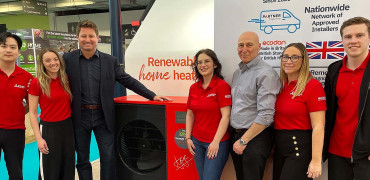The Future Homes Standard (FHS) is the UK government’s long-awaited policy to ensure all new homes built from 2025 are “zero carbon ready” meaning they’ll use low-carbon heating, have much higher energy efficiency, and won’t need expensive retrofits later to meet climate targets.
It’s a crucial piece of the UK’s net zero puzzle, but it also marks the second attempt at something like this.
In 2006, the government announced the Zero Carbon Homes policy, aiming for all new homes to be zero carbon by 2016.
Industry got behind it: manufacturers retooled, skills training programmes were launched, and low-carbon technologies like heat pumps and solar were ramping up.
But in 2015, just before the policy was due to take effect, it was abruptly scrapped, largely due to lobbying by major house builders who argued it was too costly and complex.
It’s time for an unambiguous ban on fossil-fuel heating in new homes
Inefficiency locked in
The consequences have been huge.
Since then, over 1.5 million new homes have been built with gas boilers and low insulation standards, locking in high energy use and emissions.
According to the Energy and Climate Intelligence Unit (ECIU), that rollback has added more than £5 billion to homeowners’ collective energy bills.
These homes now all need retrofitting, typically costing £15,000–£25,000 per property, just to get them in line with the UK’s net zero goals.
The National Retrofit Strategy, backed by the Construction Leadership Council, lays out just how big and costly this retrofit backlog is.
The Future Homes Standard is designed to fix that mistake.
But progress has been painfully slow. It was first promised in 2019, consulted on in 2023, and is still awaiting final confirmation.
While the government has pledged to implement it in 2025, delays and lobbying pressure have made many fear it will be watered down.
...
And then how long will it take for the industry to adjust and implement the standard?
The moment is now
This is a pivotal moment. We have the skills, the materials, the technology and the know-how to build homes that are comfortable, beautiful, energy-efficient and climate-ready.
The only thing missing is the political will to set ambitious standards and stick to them.
Done right, the FHS could be the most transformative housing policy in a generation.
There are a number of things that I believe the Future Homes Standard should do and below, I list eight that I think are vital.
I wonder if the government are brave and bold enough to do them!
1. Ban fossil fuel heating
Phase Out Gas Boilers Now: An unambiguous ban on fossil-fuel heating in new homes would cement the UK’s net-zero trajectory.
Other countries are already moving this way – the Netherlands, for example, has required all new buildings to be fossil gas-free since 2018. New York State just passed a law to ensure all new buildings use electric heating (heat pumps) instead of gas from 2026.
This clarity would give industry confidence to scale up renewable alternatives and prevent developers from clinging to old, polluting systems.
Studies show that banning gas is achievable and beneficial.
In the Netherlands, a national gas phase-out plan spurred a surge in heat pump adoption, with over 150,000 units sold in 2023, 53% more than the previous year.
Cities like Vancouver and Berkeley have also barred gas in new buildings to cut emissions and improve air quality.
If others can do it, Britain shouldn’t’ be drifting behind.
2. Clean heat as standard
Make Low-Carbon Heating the Default: The Future Homes Standard should mandate heat pumps or other low-carbon heating systems as the new normal in construction.
Rather than leaving it optional, the rule should be that highly efficient electric heat pumps (air-source or ground-source) automatically come with every new house, much as condensing gas boilers were once standard.
With new build homes this is very straightforward and nowhere near as expensive as the press often make out.
Even in apartment blocks there is now the technology for collective or cooperative clean heating through heat networks, which take wasted heat from industry, or places like data centres and re-use it to heat homes in the community.
Where there is the will there really is a way.
We can do this!
3. No more leaky homes.
A truly future-proof standard means dramatically improving the fabric efficiency of new buildings.
Every new home should have high levels of insulation, airtight construction, top-class windows, and minimal thermal bridging.
In short, houses should be so well-built that they barely need heating at all.
Industry experts insist that “no home built under the Future Homes Standard should add to the retrofit burden because of poor fabric efficiency” (architecture.com).
It costs far less to install better insulation and glazing during construction than to retrofit it later (architecture.com). Yet current proposals barely go beyond today’s basic regs.
We must raise those minimum requirements, aiming for something close to Passivhaus levels of performance (a standard proven to cut heating needs by 80%).
And even if Passivhaus standard is too radical for the government (although I can’t see why) then raising building fabric standards in the direction of Passivhaus is essential.
Pessimists in the industry will say that raising standards will drive up house prices and will make them less affordable.
I disagree with this. If building standards are raised across the entire industry then the financial adjustments should be made on the price of the land being sold for development. The land should be sold for less if the development of that land is going to cost more.
It could be argued that the profits being made on ‘development land’ are already considerably high.
4. Power from every roof
Every new home should come with solar PV as a default feature where the roof orientation and shading make it viable. It can’t be that difficult to have a roof plane that faces the sun.
Solar is now a mature, cost-effective technology that can significantly cut a home’s net energy demand.
California already requires solar panels on virtually all new homes leading the way internationally.
In the UK context, mandating solar PV will harness our rooftops to generate clean electricity right at the point of use. It helps in multiple ways: reducing grid demand and bills, providing free power for heat pumps and EV charging, and increasing energy security for homeowners.
Combined with battery storage, solar-equipped homes can even feed energy back or ride through peak pricing, contributing to a more stable, flexible grid.
The Future Homes Standard should set an expectation that developers include a minimum solar capacity (e.g. X kW per house or per square metre of roof). This would drive economies of scale in installation and spur further innovation in building-integrated solar technology like with solar tiles.
5. Measure actual performance
To guarantee all these improvements aren’t just on paper, post-occupancy evaluation (POE) should be a routine part of any new Standard.
RIBA has strongly recommended making POE mandatory for homes built under the Future Homes Standard, to verify that buildings perform as intended (architecture.com).
Currently, the performance gap, the difference between design specs and real-world energy use, is a huge issue.
By requiring developers to test homes after completion (for energy use, air-tightness, ventilation, etc.) and publish the results, we create a feedback loop that drives quality up.
It’s a call for a culture change: buildings should be judged by how they actually work for residents, not just whether they tick boxes at design stage.
Houses should be so well-built that they barely need heating at all
6. Material passports and circular design
One cutting-edge idea for truly sustainable construction is to treat buildings as banks of valuable materials, so nothing goes to landfill at end-of-life.
Enter the concept of Material Passports: digital records of all the materials and products in a building, including their qualities and recycling potential.
By tagging and tracking components (from steel beams to bricks to fixtures), we make it far easier to reclaim and reuse them in the future.
This could be transformative – imagine in 50 years, when a house is refurbished, the contractor can scan a building passport and instantly see which items can be unscrewed and reused or sold.
It keeps valuable resources in circulation and slashes waste.
The European Commission is already moving towards Digital Product Passports for construction products as part of its circular economy policy.
The UK could leapfrog by integrating this into the Future Homes Standard
7. Low-carbon materials and innovation
We must also scrutinise what we build homes with.
Concrete and steel come with very high embodied carbon footprints, and in many cases, those emissions are locked in before a home is even occupied.
The Future Homes Standard should require lower-carbon alternatives wherever possible: sustainably sourced timber structures, low-carbon cement mixes, recycled steel and plastics, and bio-based materials like straw insulation or hempcrete.
The RIBA and others have warned that ignoring embodied carbon would be a massive missed opportunity, given that construction materials account for a significant share of a new home’s total emissions.
8. Long-term policy stability
It is so important for an industry that needs to plan ahead that there is clear and strategic long-term thinking.
Policy needs to be absolutely clear and consistent.
We also need legally binding regulations to prevent policy reversal or any weakening of high standards.
This allows innovative organisations like Mitsubishi Electric to plan production, innovation and workforce development with confidence.
Every organisation in the home-building supply chain needs those assurances.
There may well be other recommendations from industry, but I think these eight would be amazing start.
Let’s hope the Future Homes Standard doesn’t disappoint.
It would be a tragic lost opportunity to transform an industry that really needs to innovate and change.
George Clarke is a TV presenter, architect, writer and Ecodan Ambassador





